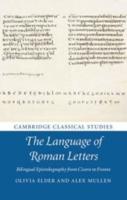
CUP (2019) h/b 320 pp £75.00 (ISBN 9781108480161)
Code-switching is a term used in the field of sociolinguistics, which describes the practice of alternating between languages or varieties of language within a discourse. It is generally understood that elite Romans code-switched between Latin and Greek, at least in certain contexts. One example would be Julius Caesar’s last words, as reported by Suetonius – not et tu, Brute! (Shakespeare’s version) but rather the Greek καὶ σύ, τέκνον.
In this monograph, two classicists apply modern techniques of code-switching analysis to a body of evidence from the ancient world: the letters of Cicero, Pliny, Fronto, and the works of Suetonius. E. and M. have identified all the instances of Greek-Latin code-switching in these corpora, and from this evidence they have built an online database (https://csrl.classics.cam.ac.uk/index.html).
In the database, E. and M. have categorised all the examples of code-switching by function, the most common being ‘Greek cultural sphere’ and ‘literary quotation’. There are methodological difficulties with this, which E. and M. are acutely aware of. For example, leading sociolinguists have created their own functional categories, and so there is no standard method to follow. In addition, categories from modern sociolinguistics do not match the ancient material particularly well. So, E. and M. create their own sociolinguistic categories, but, as academics, they are duty-bound to deconstruct these even as they create them, and so the categories will be ‘blurred’, ‘fluid’, ‘problematic’, etc.
In line with modern studies of code-switching, the data is divided into ‘intra-sentential’ and ‘inter-sentential’ categories. When a writer uses a Greek word or phrase integrated within a Latin sentence, for example, when Cicero, in a letter to Atticus, asks him about ornamenta γυμνασιώδη (‘articles of vertu suitable for a gymnasium’), this can be classified as an ‘intra-sentential code switch’. If a writer uses a complete Greek clause or sentence within a generally Latin discourse, this would be called an ‘inter-sentential code-switch’. The Julius Caesar example above would count as one of these.
The book is a mixture of macro-analysis of the data, looking at broader patterns, and close readings of individual passages. The empirical analysis tends to confirm the earlier work of scholars such as J. Adams and S. Swain, but some new readings and approaches are offered. The chapter by E. on Cicero’s letters tests the commonly-held view that code-switching into Greek is to be read as a sign of intimacy. M.’s chapter on Fronto has interesting suggestions on how views of language, identity and culture have evolved from the age of Cicero to the age of the Antonines.
Giles Gilbert
